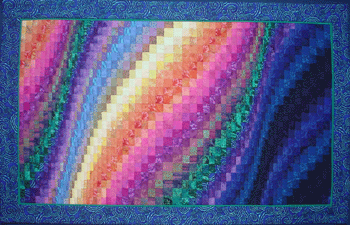| Creating the Aurora Borealis Quilt At the Lancaster quilt show in 2001, I was inspired by a bargello quilt. I am very sorry to say that I do not recall the name of the quilter*, but the way she had varied the width of the bargello strips made the surface of the large quilt seem to undulate in waves. It was wonderful and just what I wanted for the movement of the northern lights in my quilt. *Note: I am happy to acknowledge that the inspirational quilt was made by Virginia Holloway. "Slipstream" won a Judges Choice and Honorable Mention for Innovative Piecing at that show in Lancaster. Many thanks, Virginia! Those colored squiggles at the top and bottom of my sketch are all numbers. I spent a lot of time counting, measuring, and moving guide lines in PhotoShop, trying to decide how many fabrics and how to vary the width of the strips to get the undulating movement. My strips would vary by as little as a sixteenth of an inch, from one eighth up to three quarters. |
All images and text © Anna Grossnickle Hines 2005
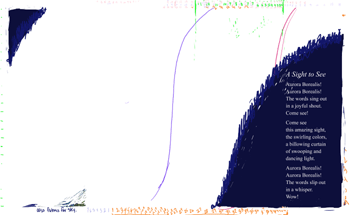
|
I needed 37 colors from dark to light and back to dark, plus a section of deep blues as a background for the poem. I selected mostly batiks for their soft color variations, filling in with a few overall patterns. I laid them on the bed of my scanner, with 1/2 inch of each showing. |
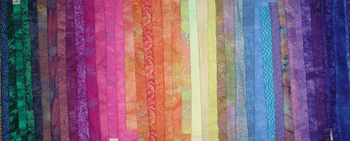
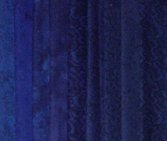
|
In PhotoShop I cut, copied and pasted, sliding each strip 1/2 inch up or down. I ended up with a much larger area vertically than I would use for the quilt. |
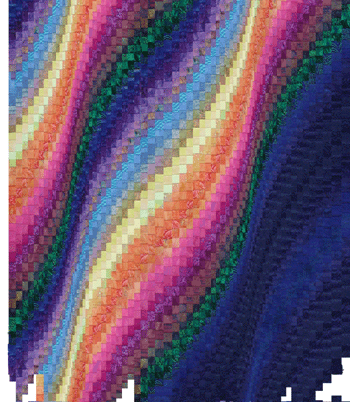
|
But that allowed me to select the section that would work best for the pages in the book with the widest section of light and a nice repetition in the upper left. I blacked out the rest and my design was done. |
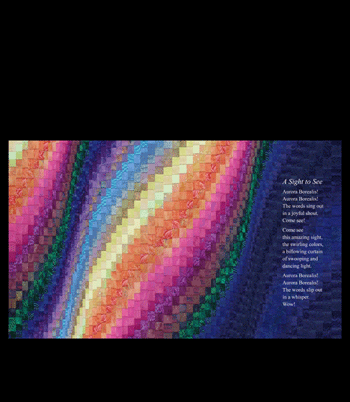
|
The next step was to cut the fabric in one inch strips and sew it together using quarter inch seams. Each color was then half an inch wide, the height of my horizontal shapes. |

|
Following Marge Edie's method described in her book, BARGELLO QUILTS, I sewed the top and bottom of this piece together making a tube, with the ends of each fabric matching. |

|
I then cut my strips in varying widths as needed for the design. Each of the resulting strips was a loop of all the colors. |
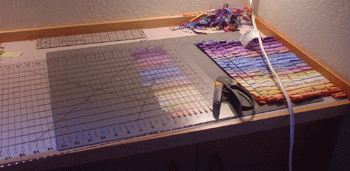
|
I measured and marked the edge of each strip on my flannel batting, which I basted to my backing material. Then, opening each strip at the color which would be at the top for that particular strip, I began placing and sewing the strips. I started with the center strip right side up, placed the next strip right sides together with it and sewed along the seam line. I pressed this strip face out, placed the next strip, stitched, and so on. I used my seam ripper to remove the unused bottom part of each strip and set these aside to be used later. |

|
A fabric that is varied can fit very well when used in large sections, but when little bits are taken they can easily be too light or dark. At this point, with 40 of 67 strips sewn, I was disturbed by some of the darker patches in the middle of the quilt, mostly those along either side of the oranges. To me, they distracted from the graceful movement. Changing them would mean unstitching every row, all the way back to the offending patches. In other words, almost the whole thing! |
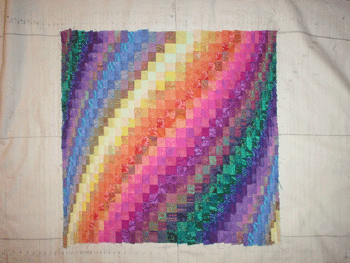
|
I resisted taking it apart and worked on completing the rest of the strips by putting together the sections I had removed from the bottom. |

|
Here the middle section is still sewn as I continue work on the strips on either side of it. |
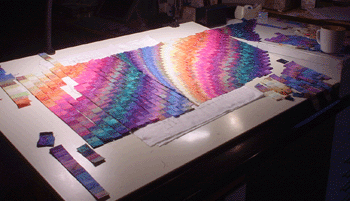
|
But I couldn't let it go when I knew I could make it better. I ripped out every seam, and replaced the offensive patches, then went back to working in the missing puzzle pieces. |
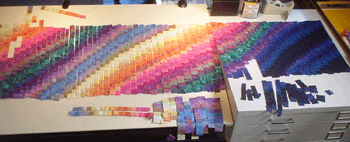
|
Since my strips were as narrow as an eighth of an inch, but still had two quarter inch seam allowances, laid out like this, they are almost three times the width of the finished quilt. |

|
See how much more smoothly those pink, orange and yellow curves blend? I was much happier with the end result and love the swirly print of the border fabric and the way it picks up the green as well as the blue. |
